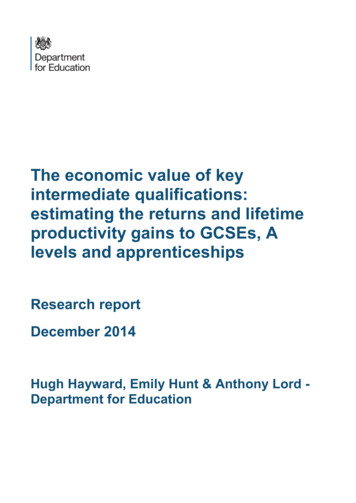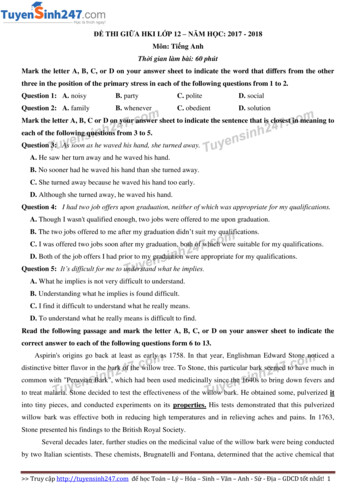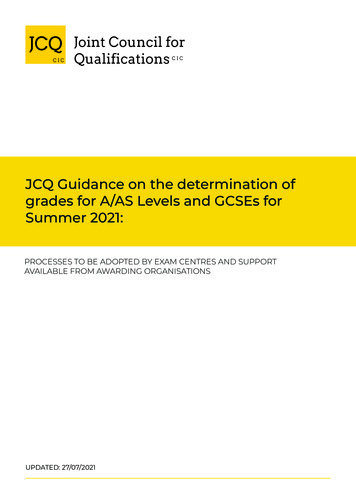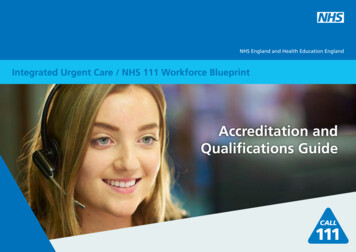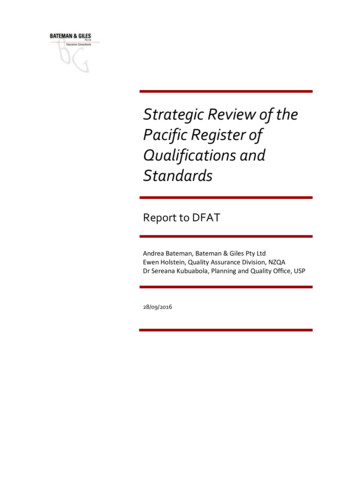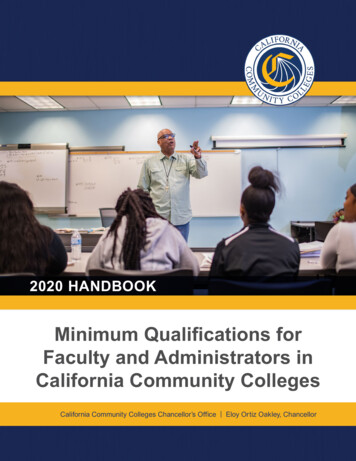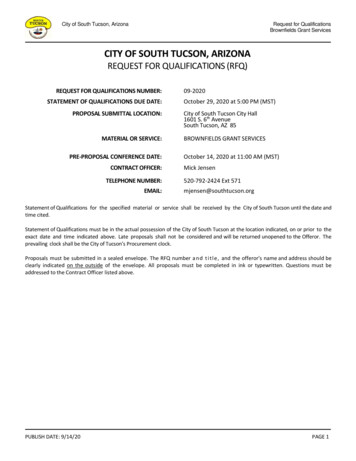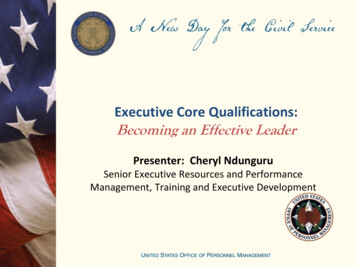
Transcription
Executive Core Qualifications:Becoming an Effective LeaderPresenter: Cheryl NdunguruSenior Executive Resources and PerformanceManagement, Training and Executive DevelopmentUNITED STATES OFFICE OF PERSONNEL MANAGEMENT
Becoming an Effective LeaderObjectives: Recognize Executive Core Qualifications (ECQs)and Leadership Competencies Implement a Proactive Approach to YourDevelopmentQuestions and Answers
Executive Core Qualifications (ECQs) andLeadership Competencies
ECQsWhat are they? The ECQs describe the leadership skills needed to succeed in theSES and reinforce the concept of an “SES corporate culture”How are they used? The ECQs are designed to assess executive experience andpotential not technical expertise. They measure whether anindividual has the broad executive skills needed to succeed in avariety of SES positionsHow were they determined? Through extensive research of the attributes of successfulexecutives in both the private and public sectors A collaboration, reflecting the best thinking of many seniorexecutives, thought leaders, and associations, as well as humanresources professionals
Executive Core Qualifications gPeopleECQs22 CompetenciesSpecific to ECQs6 FundamentalCompetenciesBusinessAcumenResultsDriven
Six Fundamental CompetenciesInterpersonalSkillsPublic nestyContinualLearningWrittenCommunication
ECQsLeading ChangeLeading PeopleResults DrivenBusiness AcumenBuilding CoalitionsThis core qualificationinvolves the ability tomanage human,financial, andinformation resourcesstrategically.This core qualificationinvolves the ability tobuild coalitions internallyand with other Federalagencies, State andlocal governments,nonprofit and privatesector organizations,foreign governments, orinternationalorganizations to achievecommon goals. FinancialManagement Human CapitalManagement TechnologyManagement Partnering Political Savvy Influencing/NegotiatingDefinitionsThis core qualificationinvolves the ability tobring about strategicchange, both within andoutside the organization,to meet organizationalgoals. Inherent to thisECQ is the ability toestablish anorganizational vision andto implement it in acontinuously changingenvironment.This core qualificationinvolves the ability tolead people towardmeeting theorganization's vision,mission, and goals.Inherent to this ECQ isthe ability to provide aninclusive workplace thatfosters the developmentof others, facilitatescooperation andteamwork, and supportsconstructive resolution ofconflicts.This core qualificationinvolves the ability to meetorganizational goals andcustomer expectations.Inherent to this ECQ is theability to make decisionsthat produce high-qualityresults by applyingtechnical knowledge,analyzing problems, andcalculating risks.Competencies Creativity andInnovation ExternalAwareness Flexibility Resilience StrategicThinking Vision ConflictManagement LeveragingDiversity DevelopingOthers Team Building Accountability CustomerService Decisiveness Entrepreneurship Problem Solving TechnicalCredibility
Proficiency Levels for LeadershipCompetenciesLevel 1- Awareness-Applies thecompetency in thesimplest situations-Requires close andextensive guidanceLevel 2- Basic-Applies thecompetency insomewhatdifficult situations-RequiresfrequentguidanceLevel 3Intermediate-Applies thecompetency vel 4Advanced-Applies thecompetency s little orno guidanceLevel 5- Expert-Applies thecompetency inexceptionallydifficultsituations-Serves as akey resourceand advisesothers
Sweet Potato Pie
CCAR ModelContextChallengedescribe a specific problem orgoaldescribe individuals and groupsyou worked with and/orenvironment in which youworked to address a challengeResultmeasures/outcomes that hadsome impact on theorganization. This demonstratesthe quality and effectiveness ofleadership skillsActiondiscuss specific actions you tookto address the challenge
Leading Change- What should the focus be? What was my organizational vision?Questionsto askyourselfwhendescribingyourexperience How did I transcend my vision into action? Whatinitiative did I take? Did I strategically initiate and implementtransformational change? How did I deal with unexpected organizationalchanges/obstacles and internal/external pressures? Did my vision achieve measurable results thatimpacted the organization?
Leading People- What should the focus be? What is the largest staff size I have led? Whatchallenges did leading a large staff present?Questionsto askyourselfwhendescribingyourexperience Was I leading versus managing? How did I lead my team through a challenge? Howdid I motivate them to achieve set goals? How did I contribute to the professional developmentof my employees (individually or as a team)? How did I deal with conflicts that arose within myteam? How did I leverage diversity amongst my team (e.g.,age, cultural, race, skill levels, perspectives)?
Results- Driven- What should the focus be?Questionsto askyourselfwhendescribingyourexperience How did the priorities and objectives I set lead to highquality/quantity results? How did I address the needs of customers andstakeholders (internal and external)? How did my decisions and actions impact results? Did I identify problems and implement solutions thatresulted in improving services?
Business Acument What should the focusbe? What is my experience in creating and administeringbudgets and resources?Questionsto askyourselfwhendescribingyourexperience How did I procure and utilize resources? Whatobstacles did I face in doing this? What was the size of budget and resources Imanaged? How much money saved? What is my experience with a multi-sector workforce?Percentage of backlog eliminated/reduced? Length ofprocessing time reduced? How did I utilize technology to create or improveprograms?
Building Coalitions- What should the focusbe?Questionsto askyourselfwhendescribingyourexperience What groups/networks (internal and external) did Ipartner with to achieve a goal? How did I bring groups together? What challenges didI face doing that? What did I do to build coalitions?
Proactive Approach to Development
OPM’s Federal Supervisory TrainingFramework
Problem Solving
OPM’s Federal Managerial TrainingFramework (DRAFT)
Developmental Tools and Resources Needs Assessments IDP 70-20-10 Model of Development SES Candidate Development Programs Executive Best Practices Networking OPM Leadership Development Matrix
Needs Assessment Recognizing the Need Formal Needs Assessments 180 or 360 Assessment Informal Needs Assessments Customer Feedback Coaching and Mentoring
Individual Development Plan Purpose in this program Essential aspects of the IDP
70-20-10 Model of Development
70- 20-10 Developmental Activities70%20%10%Experience LearningThrough DoingExposure LearningThrough OthersEducation LearningThrough Resources Challenging on-thejob assignments Job rotationprograms Mentoring others Project teams/taskforces Conducting research Tackling a start-up or“fix- it” issue in yourarea Mentors/role models Feedback, coaching Visibility with keyleaders Lead projects/teams Instructor led courses E-Learning programs Formal educationprograms Professional associationsand/or certifications Reading professionalbooks, magazines orjournals
SES Candidate Development Programs(SESCDP) OPM-approved training program designed todevelop the executive qualifications ofemployees with strong executive potential toqualify them for an appointment into the SES SESCDPs are typically 12-24 months Open to all qualified individuals from within oroutside the Federal Government, like SESpositions; typically GS-14s/GS-15s orequivalent levels Address the ECQs
SESCDP Program GraduationRequirements Complete an Executive Development Plan, based onan individual needs assessment Participate in formal training of at least 80 hours thataddress the ECQs and include individuals from outsidethe candidate’s agency Participate in developmental assignments totaling atleast 4 months of full-time service outside thecandidate’s position of record Participate in a mentoring relationships with amember of the SES
Executive Best Practices Guide Contains a compilation of best practices usedby the public and private sector to support thecontinued learning of executives Information was gathered through anextensive literature review, and interviewswith Fortune 500 companies and Federalagencies ls.aspx?TransmittalID 5241
Networking Do’s & Don’tsNetworking is:Networking is NOT: Finding your community Finding someone withinfluence to pull strings Developing long-termrelationships Making introductions Looking for opportunities innew places Being thoughtful aboutwhich events to attend Being sincere to those youmeet Remembering names anddetails about others Using others to get what youwant Attending every single eventpossible Forcing someone to meetwith you and help Providing false informationabout yourself Coming across as insincere oruninterested
Networking Cohort Events What else?
OPM Leadership Development Matrix Adapted from the draft OPM EffectiveLearning Interventions for Developing ECQs Highlights the most effective and targetedapproach for developing each competencywithin the ECQs
OPM Leadership Development Matrix Five classes of leadership developmentinterventions and activities Instructor-ledExperiential activitiesDevelopmental relationshipsAssessments and feedbackSelf-development
OPM Leadership Development MatrixLeading Change
The Uncanny Valley
OPM Leadership Development MatrixFundamental Competencies
Valuable Resources OPM Tools & Guidance (via OPM.gov) OPM Executive Development Best Practices Guide OPM Supervisory Training Framework OPM Proficiency Levels for Leadership Competencies Guide to SES Qualifications OPM Websites www.opm.gov/ses -service/faqs/
Q&A
OPM-approved training program designed to develop the executive qualifications of employees with strong executive potential to qualify them for an appointment into the SES . OPM Leadership Development Matrix Adapted from the draft OPM Effective Learning Interventions for Developing ECQs
